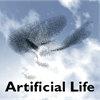Survival and Evolutionary Adaptation of Populations Under Disruptive Habitat Change: A Study With Darwinian Cellular Automata
IF 1.5
4区 计算机科学
Q4 COMPUTER SCIENCE, ARTIFICIAL INTELLIGENCE
引用次数: 0
Abstract
The evolution of living beings with continuous and consistent progress toward adaptation and ways to model evolution along principles as close as possible to Darwin’s are important areas of focus in Artificial Life. Though genetic algorithms and evolutionary strategies are good methods for modeling selection, crossover, and mutation, biological systems are undeniably spatially distributed processes in which living organisms interact with locally available individuals rather than with the entire population at once. This work presents a model for the survival of organisms during a change in the environment to a less favorable one, putting them at risk of extinction, such as many organisms experience today under climate change or local habitat loss or fragmentation. Local spatial structure of resources and environmental quality also impacts the capacity of an evolving population to adapt. The problem is considered on a probabilistic cellular automaton with update rules based on the principles of genetic algorithms. To carry out simulations according to the described model, the Darwinian cellular automata are introduced, and the software has been designed with the code available open source. An experimental evaluation of the behavioral characteristics of the model was carried out, completed by a critical evaluation of the results obtained, parametrically describing conditions and thresholds under which extinction or survival of the population may occur.破坏性生境变化下种群的生存与进化适应:达尔文细胞自动机研究》。
生物在进化过程中不断地、持续地适应环境,以及如何按照尽可能接近达尔文的原则建立进化模型,是人工生命的重要关注领域。虽然遗传算法和进化策略是模拟选择、交叉和变异的好方法,但不可否认的是,生物系统是一个空间分布的过程,在这个过程中,生物体与局部可用的个体相互作用,而不是同时与整个种群相互作用。这项研究提出了一个生物生存模型,用于描述当环境发生变化,变得不利于生物生存,使生物面临灭绝风险时,生物的生存状况,例如当今许多生物在气候变化或局部栖息地丧失或破碎的情况下的生存状况。当地资源和环境质量的空间结构也会影响不断进化的种群的适应能力。该问题是在概率蜂窝自动机上考虑的,其更新规则基于遗传算法原理。为了根据所描述的模型进行模拟,引入了达尔文细胞自动机,并设计了开源代码软件。对模型的行为特征进行了实验评估,并对所获得的结果进行了批判性评估,从参数上描述了种群灭绝或生存可能发生的条件和阈值。
本文章由计算机程序翻译,如有差异,请以英文原文为准。
求助全文
约1分钟内获得全文
求助全文
来源期刊

Artificial Life
工程技术-计算机:理论方法
CiteScore
4.70
自引率
7.70%
发文量
38
审稿时长
>12 weeks
期刊介绍:
Artificial Life, launched in the fall of 1993, has become the unifying forum for the exchange of scientific information on the study of artificial systems that exhibit the behavioral characteristics of natural living systems, through the synthesis or simulation using computational (software), robotic (hardware), and/or physicochemical (wetware) means. Each issue features cutting-edge research on artificial life that advances the state-of-the-art of our knowledge about various aspects of living systems such as:
Artificial chemistry and the origins of life
Self-assembly, growth, and development
Self-replication and self-repair
Systems and synthetic biology
Perception, cognition, and behavior
Embodiment and enactivism
Collective behaviors of swarms
Evolutionary and ecological dynamics
Open-endedness and creativity
Social organization and cultural evolution
Societal and technological implications
Philosophy and aesthetics
Applications to biology, medicine, business, education, or entertainment.
 求助内容:
求助内容: 应助结果提醒方式:
应助结果提醒方式:


